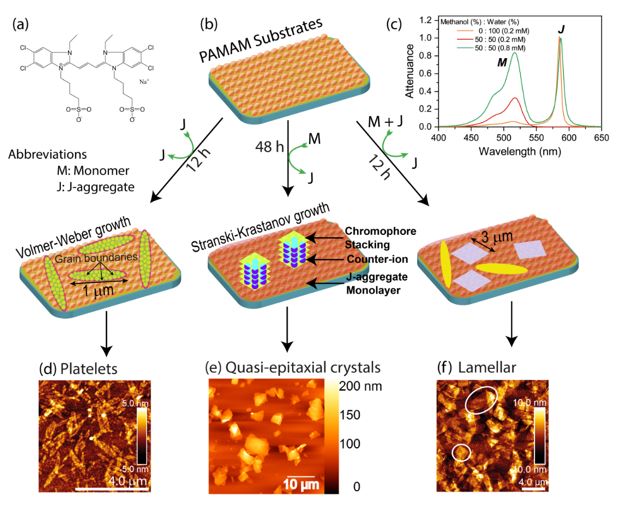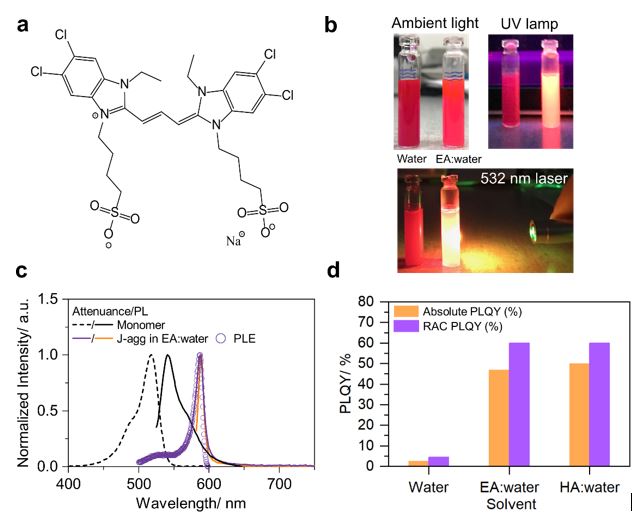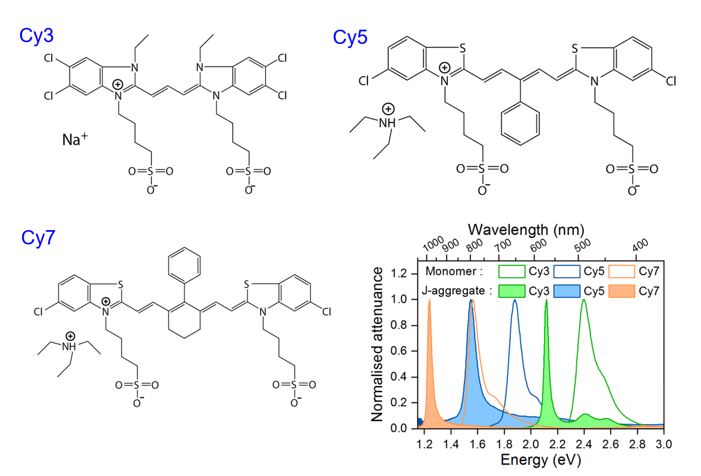Artificial molecular aggregates
In nanostructured materials, intriguing electrical and optical properties are observed due to quantum phenomena. The properties are tunable and enable novel applications.
Of specific interest is a phenomena observed in highly ordered assemblies of organic dyes. Strong near field interactions between molecular electronic transitions allow light transfer from one molecule to the others via a resonant de-excitation/excitation process. This coherent motion of (localized) excitation is e.g. the underlying mechanism of energy transfer in light-harvesting complexes in plants and some types of bacteria and algae. It should be noted that this energy transport mechanism is very different from exciton transport in inorganic semiconductors, which is determined by the free charge carrier mobility.
We investigate these effects in so-called J-aggregates of cyanine dyes. Light is collectively absorbed by many molecules (exciton delocalization), which leads to narrow absorption and emission bands, strongly increased absorption, super radiance, and other intriguing properties.
Exciton delocalization is also the reason why the Photoluminescence quantum yield (PLQY) in cyanine J-aggregates is typically very low (h ≈ 5%) as grain boundaries and defects readily quench the excitation. The potential of J-aggregates in novel devices can only be exploited when defect free, large molecular assemblies can be fabricated. Our research thus focusses on the controlled growth of J-aggregates in films and solution and on the PLQY limiting quenching mechanisms.
J-aggregate growth in thin films
Cyanine dye J-aggregates can be grown in high quality on surfaces functionalized with Polyamidoamine dendrimers (PAMAM). Depending on the conditions, different growth modes dominate. Lamellar films give rise to significantly enhanced radiative decay. We identified exciton – charge quenching as a dominant non-radiative decay path.

Figure: (a) Chemical structure of the TDBC dye. (b) Schematic showing methodologies to control J-aggregates growth following Volmer-Weber and Stranski-Krastanov growth models. (c) Attenuance of dye solution by varying the monomer and J-aggregate phase content leads to different types of J-aggregate morphologies like (d) platelets, (e) quasi-epitaxial crystals and (f) lamellar on glass substrates functionalized with PAMAM, as observed with scanning probe microscopy. Presence of mixed leaf-like and stripe J-aggregates in lamellar films are marked with white rings in (f). Reprinted from Advanced Functional Materials, 2018, 1806997. Copyright 2018 WILEY-VCH Verlag GmbH & Co. KGaA, Weinheim.
References:
R. Steiger et al. J-aggregation of cyanine dyes by self-assembly. Colloids and Surfaces B: Biointerfaces, 2009, 74(2), 484. https://doi.org/10.1016/j.colsurfb.2009.08.020
S. Anantharaman et al. Excitonic channels from bio-inspired templated supramolecular assembly of J-aggregate nanowires. Nanoscale, 2019, 11(14), 6929. https://doi.org/10.1039/C8NR10357G
S. Anantharaman et al. Exciton dynamics and effects of structural order in morphology-controlled J-aggregate assemblies. Advanced Functional Materials, 2018, 1806997. https://doi.org/10.1002/adfm.201806997
Formation of highly luminescent J-aggregates in microemulsions
Cyanine J-aggregates with record PLQY h > 50% form at water / amine interfaces in microemulsions.

Figure: Chemical structure of the TDBC dye (a). Attenuance spectra for monomers in methanol, J-aggregates in ethylamine-water solution with their corresponding photoluminescence (PL) spectra. Photoluminescence excitation (PLE) spectra for the PL emission wavelength = 586 nm measured from J-aggregates in ethylamine:water is shown as open circles (b). Photographs of J-aggregates in water and water/EA blend solutions showing PL under ambient light, UV lamp and 532 nm laser excitation (c). Absolute PLQY and reabsorption corrected (RAC) PLQY for 1 mM J-aggregate solutions in water, and blends of water/EA and water/HA with 50/50 ratios by volume (d).
Reference:
S. Anantharaman, et al. Enhanced room-temperature photoluminescence quantum yield in morphology controlled J-aggregates. Advanced Science, 2021, 1903080. https://doi.org/10.1002/advs.201903080
Photodetectors
Exploiting the intrinsic narrow absorption width and high extinction coefficient of J-aggregates, we realized narrowband organic photodetectors with spectral bandwidth below 50 nm, while employing ultrathin active films of about 10-20 nm. Spectral sensitivity ranging from the red to the near infrared domain up to 1000 nm could be achieved by varying the polymethine length of the cyanine dyes.

Figure: Chemical structure of the trimethine, pentamethine and heptamethine dyes and comparison of attenuance peaks of aggregate thin films with monomers.
Reference
S. Anantharaman, et al. Exploiting supramolecular assemblies for filterless ultra-narrowband organic photodetectors with inkjet fabrication capability. Journal of Materials Chemistry C, 2019, 7, 14639. https://doi.org/10.1039/C9TC04773E
-
Share
